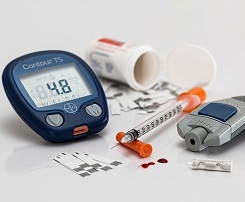![]()
 Diabetes is a health condition that is currently seeing one of the highest and most precipitous rates of increase in diagnoses made among the American population. It can cause a pretty large decrease in overall quality of life in the short term, and can be a contributor to major health problems in the long run.
Diabetes is a health condition that is currently seeing one of the highest and most precipitous rates of increase in diagnoses made among the American population. It can cause a pretty large decrease in overall quality of life in the short term, and can be a contributor to major health problems in the long run.
It is for this reason that diabetes is one of the most closely studied and monitored diseases in the modern medical field. When widely occurring in a population, it can be a major factor for the swell of nationwide health costs and loss of efficiency.
So what exactly is causing this phenomenon? With most conditions that do not result from exposure to certain pathological external factors, it is quite rare to see such a rapid growth in the numbers of people who become afflicted with said illness. As it turns out, the key to answering this question lies in the changing style of living among the American population.
Just a few decades ago, most people spent a significant amount of their day walking or riding a bike as transportation. But as jobs have gotten more sedentary and commutes have grown longer and only possible to perform with an automobile, the general public has suddenly stopped getting nearly as much exercise.
Add to this the fact that high fat and high sugar foods are less expensive, easier to buy, and more addictive than ever before, and you get skyrocketing obesity rate. These conditions make developing diabetes all too easy.
It is projected that within the next decade, up to a third of the total American population will suffer from diabetes.
For anyone who suspects that they may already be seeing the signs of the disease should immediately talk to their physician. Diabetes can be managed with treatment and lifestyle changes, but can cause major bodily harm if allowed to continue unchecked.
Those who feel that they may be at risk for developing diabetes often have some questions about the disease. By far, the single most common point of inquiry is regarding the difference between type 1 and type 2 diabetes.
At face value, these conditions have similar names and share a lot of symptoms, which can make it difficult to immediately understand how they differ. For anyone who is curious about these two related conditions, here is a guide to understanding the differences between type 1 and type 2 diabetes.
Type 1 Diabetes
While the two diseases may seem very much alike in terms of name and associated symptoms, the reality is that they have very different physical causes. Type 1 diabetes starts in the pancreas. Due to a genetic quirk or some other type of mutation, patients with this condition do not produce or produce a dearth of the cells in the pancreas that produce insulin.
This means that there is a low or absent level of insulin in the blood stream. Insulin is needed to help cells around the body absorb sugar, which keeps them powered and capable of doing their job.
This will generally lead to feelings of fatigue, weight loss, and constant feelings of hunger.
Type 1 diabetes generally sets in at a very young age, although some exceptions exist. It is generally not possible to prevent type 1 diabetes.
Type 2 Diabetes
In the pancreas of a patient with type 2 diabetes, there is a normal level of insulin producing cells. The problem is that the other cells in the body have stopped responding to insulin.
This is because previously high levels of blood sugar have triggered overproduction of insulin, more than was needed to absorb the sugar. Over time, this excess of insulin causes cells to stop responding.
This will result in tingling and numbness in the extremities, as well as frequent urination and sweating. This condition can be treated and reversed if caught in an early stage, and can happen at any time in a person’s life.
The treatments available for both types of diabetes do not differ by much. The best treatment is largely lifestyle based; both diseases benefit from frequent exercise and healthy eating habits.
For more information and explanations about the difference between type 1 diabetes and type 2 diabetes we will recommend you checking the video below…


 OneCareNow is a general weblog that was created by several writers with a specific goal in mind: To offer one place that covers important topics which people really care about.
OneCareNow is a general weblog that was created by several writers with a specific goal in mind: To offer one place that covers important topics which people really care about.![Back Pain Breakthrough by Palmer & Dr. Young [2024 Review]](https://www.onecarenow.org/wp-content/uploads/2021/02/Back-Pain-Breakthrough-Young-Amy-50x50.png)
![Vincent’s Midas Manifestation System Review [Updated 2024]](https://www.onecarenow.org/wp-content/uploads/2021/02/Midas-Manifestation-50x50.png)
![The NEW Happiness Code by David [Updated 2024 Review]](https://www.onecarenow.org/wp-content/uploads/2021/01/The-NEW-Happiness-Code-50x50.png)
![Michael Christianson’s Manifestation Sigil Review [2024]](https://www.onecarenow.org/wp-content/uploads/2021/01/Manifestation-Sigil-50x50.png)
